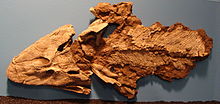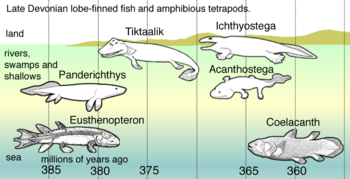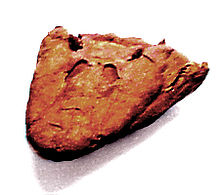
Tiktaalik
Did you know...
SOS Children offer a complete download of this selection for schools for use on schools intranets. With SOS Children you can choose to sponsor children in over a hundred countries
| Tiktaalik roseae Temporal range: Late Devonian, 375Ma |
|
|---|---|
 |
|
| Tiktaalik in the Field Museum, Chicago. | |
| Scientific classification |
|
| Kingdom: | Animalia |
| Phylum: | Chordata |
| Class: | Sarcopterygii |
| Order: | Elpistostegalia |
| Clade: | Stegocephalia |
| Genus: | †Tiktaalik Daeschler, Shubin & Jenkins, 2006 |
| Type species | |
| †Tiktaalik roseae Daeschler, Shubin & Jenkins, 2006 |
|
Tiktaalik (pron.: / t ɪ k ˈ t ɑː l ɨ k /) is a monospecific genus of extinct sarcopterygian (lobe-finned fish) from the late Devonian period, with many features akin to those of tetrapods (four-legged animals). It is an example from several lines of ancient sarcopterygian fish developing adaptations to the oxygen-poor shallow-water habitats of its time, which led to the evolution of tetrapods. Well-preserved fossils were found in 2004 on Ellesmere Island in Nunavut, Canada.
Tiktaalik lived approximately 375 million years ago. Paleontologists suggest that it is representative of the transition between non-tetrapod vertebrates (fish) such as Panderichthys, known from fossils 380 million years old, and early tetrapods such as Acanthostega and Ichthyostega, known from fossils about 365 million years old. Its mixture of primitive fish and derived tetrapod characteristics led one of its discoverers, Neil Shubin, to characterize Tiktaalik as a " fishapod".
Tiktaalik roseae is the only species classified under the genus. The name Tiktaalik is an Inuktitut word meaning " burbot", a freshwater fish related to true cod. The "fishapod" genus received this name after a suggestion by Inuit elders of Canada's Nunavut Territory, where the fossil was discovered. The specific name roseae cryptically honours an anonymous donor.
Putative tetrapod footprints found in Poland and reported in Nature in January 2010 were "securely dated" at 10 million years older than the oldest known elpistostegids. If this is a true tetrapod record, Tiktaalik was a "late-surviving relic" rather than the original transitional form. An alternative interpretation is that the Polish trackways, which do not have digital impressions, were made by walking fish
Description
Tiktaalik provides insights on the features of the extinct closest relatives of the tetrapods. Unlike many previous, more fishlike transitional fossils, the "fins" of Tiktaalik have basic wrist bones and simple rays reminiscent of fingers. The homology of distal elements is uncertain; there have been suggestions that they are homologous to digits, although this is incompatible with the digital arch developmental model because digits are supposed to be postaxial structures, and only three of the (reconstructed) eight rays of Tiktaalik are post-axial. However, the proximal series can be directly compared to the ulnare and intermedium of tetrapods. The fin was clearly weight bearing, being attached to a massive shoulder with expanded scapular and coracoid elements and attached to the body armor, large muscular scars on the ventral surface of the humerus, and highly mobile distal joints. The bones of the fore fins show large muscle facets, suggesting that the fin was both muscular and had the ability to flex like a wrist joint. These wrist-like features would have helped anchor the creature to the bottom in fast moving current.
Also notable are the spiracles on the top of the head, which suggest the creature had primitive lungs as well as gills. This would have been useful in shallow water, where higher water temperature would lower oxygen content. This development may have led to the evolution of a more robust ribcage, a key evolutionary trait of land living creatures. The more robust ribcage of Tiktaalik would have helped support the animal’s body any time it ventured outside a fully aquatic habitat. Tiktaalik also lacked a characteristic that most fishes have—bony plates in the gill area that restrict lateral head movement. This makes Tiktaalik the earliest known fish to have a neck, with the pectoral girdle separate from the skull. This would give the creature more freedom in hunting prey either on land or in the shallows.

- Panderichthys, suited to muddy shallows;
- Tiktaalik with limb-like fins that could take it onto land;
- Early tetrapods in weed-filled swamps, such as:
- Acanthostega which had feet with eight digits,
- Ichthyostega with limbs.
Tiktaalik is a transitional fossil; it is to tetrapods what Anchiornis is to birds, troodonts and dromaeosaurids. While it may be that neither is ancestor to any living animal, they serve as evidence that intermediates between very different types of vertebrates did once exist. The mixture of both fish and tetrapod characteristics found in Tiktaalik include these traits:
- Fish
- fish gills
- fish scales
- fish fins
- "Fishapod"
- half-fish, half-tetrapod limb bones and joints, including a functional wrist joint and radiating, fish-like fins instead of toes
- half-fish, half-tetrapod ear region
- Tetrapod
- tetrapod rib bones
- tetrapod mobile neck with separate pectoral girdle
- tetrapod lungs
Tiktaalik generally had the characteristics of a lobe-finned fish, but with front fins featuring arm-like skeletal structures more akin to a crocodile, including a shoulder, elbow, and wrist. The fossil discovered in 2004 did not include the rear fins and tail. It had rows of sharp teeth of a predator fish, and its neck could move independently of its body, which is not possible in other fish. The animal had a flat skull resembling a crocodile's; eyes on top of its head, suggesting that it spent a lot of time looking up; a neck and ribs similar to those of tetrapods, with the ribs being used to support its body and aid in breathing via lungs; well developed jaws suitable for catching prey; and a small gill slit called a spiracle that, in more derived animals, became an ear.
The fossils were found in the " Fram Formation", deposits of meandering stream systems near the Devonian equator, suggesting a benthic animal that lived on the bottom of shallow waters and perhaps even out of the water for short periods, with a skeleton indicating that it could support its body under the force of gravity whether in very shallow water or on land. At that period, for the first time, deciduous plants were flourishing and annually shedding leaves into the water, attracting small prey into warm oxygen-poor shallows that were difficult for larger fish to swim in. The discoverers said that in all likelihood, Tiktaalik flexed its proto-limbs primarily on the floor of streams and may have pulled itself onto the shore for brief periods. Neil Shubin and Ted Daeschler, the leaders of the team, have been searching Ellesmere Island for fossils since 2000
| “ | We're making the hypothesis that this animal was specialized for living in shallow stream systems, perhaps swampy habitats, perhaps even to some of the ponds. And maybe occasionally, using its very specialized fins, for moving up overland. And that's what is particularly important here. The animal is developing features which will eventually allow animals to exploit land. | ” |
|
—Ted Daeschler, |
||
Discovery
In 2004, three fossilized Tiktaalik skeletons were discovered in rock formed from late Devonian river sediments on Ellesmere Island, Nunavut, in northern Canada. At the time of the species' existence, Ellesmere Island was part of the continent Laurentia (modern eastern North America and Greenland), which was centered on the equator and had a warm climate.
The remarkable find was made by a paleontologist who noticed the skull sticking out of a cliff. On further inspection, the ancient animal was found to be in excellent condition for a 383-million-year-old specimen.
The discovery, made by Edward B. Daeschler of the Academy of Natural Sciences, Neil H. Shubin from the University of Chicago, and Harvard University Professor Farish A. Jenkins, Jr, was published in the April 6, 2006 issue of Nature and quickly recognized as a classic example of a transitional form. Jennifer A. Clack, a Cambridge University expert on tetrapod evolution, said of Tiktaalik, "It's one of those things you can point to and say, 'I told you this would exist,' and there it is."
| “ | After five years of digging on Ellesmere Island, in the far north of Nunavut, they hit pay dirt: a collection of several fish so beautifully preserved that their skeletons were still intact. As Shubin's team studied the species they saw to their excitement that it was exactly the missing intermediate they were looking for. 'We found something that really split the difference right down the middle,' says Daeschler. | ” |
|
— New Scientist, |
||
Taking a detailed look at the internal head skeleton of Tiktaalik roseae, in the October 16, 2008, issue of Nature, researchers show how Tiktaalik was gaining structures that could allow it to support itself on solid ground and breathe air, a key intermediate step in the transformation of the skull that accompanied the shift to life on land by our distant ancestors.





